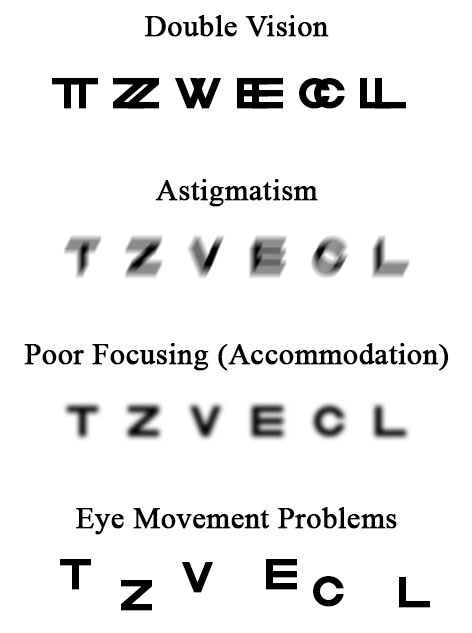We’ve spent a lot of time thinking about how excellent vision can make a difference in a child’s life. Important milestones need to be reached! Visual skills need to be learned! Read on to discover our view on what’s important to know.
Learning to See
A baby’s eyes and visual system is almost completely fully developed at birth! But when your little bundle of joy comes into the world, that’s when your baby starts learning to see. During the first months, he or she begins to learn to move the eyes in all directions, in towards the face and then out to things far away. Focusing begins to improve in speed and accuracy, and depth perception gets better and better.
The American Optometric Association (AOA) recommends a baby’s first eye exam between 6-12 months old. Click here to learn more about Infant Eye Exams!
As kids grow older, for the most part they are expected to develop these visual skills naturally. Most do! Routine visits to the doctor do not test for focusing, eye movement, and eye teaming skills, though, and problems during this phase of development often are left undetected.
Seeing to Learn
During a child’s early elementary school years, from 1st to 3rd grade, there is a shift from learning to see (reaching for and playing with toys, identifying shapes, colors, letters, numbers, and basic words, etc.) to seeing to learn. Students begin to read and study and are expected to take more and more information through their eyes. Most of what is learned during school is “visual information“, whether words, pictures, graphics, charts, projected on a screen, or on a page.
The Problem With How Vision Is Screened
Our eyes need to align and focus properly in order to see properly. The basis of vision screenings performed at pediatricians clinics and schools, though, is reading letters. Simple screening tests in which a child only reads letters, however, can commonly miss many vision problems, since just reading the letters does not require them to be clear. Here are some examples of problems that might pass a vision screening, but still affect visual function:
See how easy it was to read the letters, even without perfect vision? Also remember how much pressure kids are under to “pass“!
A Case Study
Now let’s consider a common case we see in the clinic. An elementary school-aged girl passes a vision screening at school but has problems with paying attention during school, takes a long time to finish homework, and generally does not like reading. She is clearly very intelligent, but needs to work very hard to make good grades, and this year as she has started to pick up playing soccer, her grades have started to slip. She loves playing soccer, but her parents have told her that if she doesn’t get her grades up, she won’t be able to play any more, which upsets her greatly. She passes vision screenings every year at the doctor, but has started complaining of headaches after starting to work on her homework for almost an hour per night.
We find during her exam:
She has a prescription of:
Right Eye: +1.75-1.25x075
Left Eye: +1.25-1.00x105
(Meaning: She has a small amount of astigmatism in both eyes at different axes, that is, the curvature of her eye’s focusing structures distorts the image in a different direction in each eye)Her eye’s posture is 10 Exophoria at Near.
(Meaning: Her eyes tend to sit slightly apart when looking at something up close)Her Near Point of Convergence Break is at 20cm and Recovery is at 25cm.
(Meaning: She has trouble keeping her eyes together when looking up close)
This picture to the left demonstrates what this child might “see“ like when looking at a lesson at school. Notice that all of the words are slightly blurred and as the words get closer, they tend to split apart more. All of the words are legible, and the child can complete the lesson, but notice how difficult everything is to see!
The treatment plan for this child is first and foremost to prescribe glasses to correct the astigmatism and potentially help the convergence problem. But she may need additional vision therapy to improve her visual skills.
A Child May Not Complain
It’s important to remember that a child with a vision problem usually has never seen any better than they see now, and they consider their vision to be “normal“, because it’s all they have ever known! They also may routinely pass vision exams and screenings, and may be very proud of the fact that they have “20/20 Vision”, and assume that everyone else sees the same way they do.
The Answer: A Comprehensive Eye Exam
A comprehensive eye examination is performed by an eye care specialist (an Optometrist or Ophthalmologist) and is a more thorough screening of visual function than a school or pediatrician’s screening. An eye care specialist experienced in the visual development of children should also assess focusing, eye teaming, eye movement, and eye alignment.
We recommend checking early and often, of course! A first eye exam should be performed between 6 months and 1 year old, followed by exams at about 3 years old and 5 years old. This will make sure that the eyes are performing their best before starting school.
Are you looking for a pediatric optometrist in the Kent, Auburn, Renton, Covington, Maple Valley, Enumclaw, or Black Diamond area?
Get ahead of any problems before they start! Schedule an eye exam today!
Book an appointment now!
Call us at 253.201.2515 or click below to schedule.
We’re happy to see kids 0-99!



